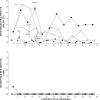Progressing from identification and functional analysis of precursor behavior to treatment of self-injurious behavior
- PMID: 22844142
- PMCID: PMC3405930
- DOI: 10.1901/jaba.2012.45-361
Progressing from identification and functional analysis of precursor behavior to treatment of self-injurious behavior
Abstract
This multiple-study experiment evaluated the utility of assessing and treating severe self-injurious behavior SIB based on the outcomes of a functional analysis of precursor behavior. In Study 1, a precursor to SIB was identified using descriptive assessment and conditional probability analyses. In Study 2, a functional analysis of precursor behavior was conducted. Finally, study 3 evaluated the effects of a treatment in which precursor behavior produced the maintaining variable identified in the precursor functional analysis. Studies 1 and 3 were conducted in two settings in the participants natural environment, where data collection was ongoing throughout the course of the study. Results showed that it was possible to identify a precursor to infrequent but severe SIB, that a functional analysis of precursor behavior suggested a clear operant function, and that treatment based on the results of the precursor functional analysis reduced SIB in the natural environment.
Keywords: functional analysis; lagsequential analysis; naturalistic treatment; precursor behavior; problem behavior.
Figures




References
MeSH terms
LinkOut - more resources
Full Text Sources
Medical

